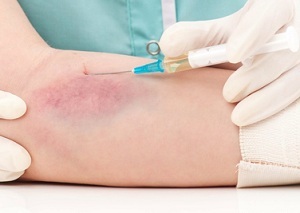 Currently, thrombophlebitis is a common disease. This pathology is an inflammatory reaction that affects the veins.
Currently, thrombophlebitis is a common disease. This pathology is an inflammatory reaction that affects the veins.
Thus in the formed lumens there are so-called thrombi. Often, the disease affects the legs, but the location of the location may be different, such as hands.
The term thrombophlebitis is used by physicians for the designation of thrombosis and inflammation in the superficial veins. In this case, the term phlebothrombosis is used to refer to a disease localized in deep veins.
There are cases when there is no thrombus, but the development of the inflammatory process of the walls is observed, then another designation is used - phlebitis.
Contents
- Causes and Risk Factors
- How does it manifest and look in life?
- Diagnosis
- Treatment of the disease
- Surgical intervention
- Prescriptions from the "grandmother"
- Probable complications and prognosis
Causes and risk factors
The main causes that trigger the development of thrombophlebitis of the upper extremities:
- development of the inflammatory process( general or local);
- venous wall damage;
- slowing the usual rate of blood flow, which can cause venous congestion;
- propensity to form blood clots( hereditary factor or acquired pathology).
Often the disease develops in the deep veins, and often after a large number of drugs that are administered intravenously and can cause irritation. Also, the pathology can be the result of a local trauma or an insect bite. 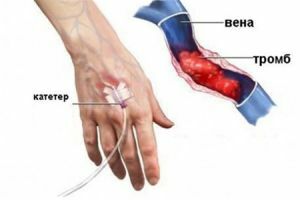
In addition, thrombophlebitis of the upper extremities of the deep veins can develop due to the prolonged stay of the catheter in the hand, which in turn promotes the formation of blood clots on the walls. Also, the trigger mechanism is malignant tumors, the presence of an implanted cardiac defibrillator or an artificial pacemaker.
The cause of deep vein thrombophlebitis is also intensive workload. In general, this pathology affects professional athletes of weightlifters engaged in baseball, swimming, tennis and other. In the process, the deep veins are squeezed by trained muscles, and this is the cause of impaired blood flow.
Unlike deep vein thrombophlebitis, the development of the disease in the surface of the surface vessels can occur on an even place for no apparent reason. Pathology is often a complication of local inflammatory processes, injuries, surgical intervention and hypothermia.
Infectious disease, allergy, pathological processes that require finding the upper limbs in an immobilized state, are a factor provoking the disease.
Risk factors:
- Vein dilatation - varicose veins;
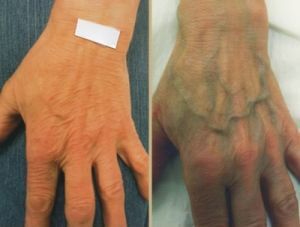
- forced prolonged long-term bed rest due to surgery;
- diseases that are infectious;
- operations during childbirth and performed during pregnancy;
- catheterization or puncture of veins;
- dehydration;
- overweight( obesity);
- stroke, which can subsequently cause limb paralysis;
- is a passive lifestyle;
- application methods for the treatment of cancer;
- susceptibility to increased blood clotting;
- use of hormonal contraceptives and other hormonal agents.
How does it appear and look in life?
The main symptoms of the disease include:
- in the affected area, redness and denseness are observed;
- soreness;
- increased body temperature;
- swelling of a local extremity.
The main sign of the development of the disease in the field of superficial veins is puffiness, pain and general inflammatory processes.
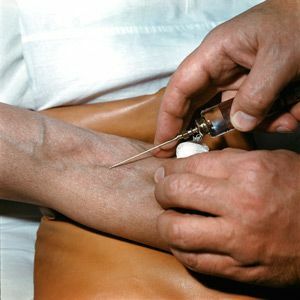 Often thrombophlebitis of superficial veins is a provocateur of lymphadenitis, and this in turn is accompanied by infiltrates on the affected veins and pronounced hyperemia. At the same time, the body temperature can reach 39 degrees.
Often thrombophlebitis of superficial veins is a provocateur of lymphadenitis, and this in turn is accompanied by infiltrates on the affected veins and pronounced hyperemia. At the same time, the body temperature can reach 39 degrees.
Although there is a small swelling, the limb remains the same size. During bodily movements, pain can be felt. In the place where the thrombus was formed, an infiltrate is probed. Lymphadenitis is observed at the advanced stage of the disease.
Depending on the case, the symptoms of thrombophlebitis of the upper limbs may be more or less pronounced. This indicates the form of the disease. If the acute form of the disease develops, the pain is quite strong, and relief comes a few days later, but the discomfort remains with the palpation.
Depression of deep veins can lead to hyperemia and infiltration. When considering the limb, the processes manifest themselves as a crimson band that covers the skin area in the affected area. Often, dense nodules are probed, and palpation is painful. In addition, there is a seal on the affected area.
Diagnosis of
To determine which studies will be required, the patient is examined by a specialist. Depending on the case, one of the following methods is selected:
- D-Dimet, coagulogram and clinical blood test ;
- duplex scanning of veins and dopplerography - ultrasound methods, now an integral part of the diagnosis;
- X-ray examination of the venous bed , which is carried out by the introduction of a contrasting special preparation that stains from inside the vessels( it is used extremely rarely);
- if after ultrasonic diagnostic methods the information received is insufficient, then magnetic resonance imaging and computed tomography is used.
When all procedures are performed, additional diagnostic measures may be required to establish the cause of the disease. Including to clarify the nature of the dynamics of the pathological process, control studies are conducted.
Treatment of the disease
First of all, the treatment of thrombophlebitis is aimed at eliminating the causes of the development of the disease, preventing the development of thrombosis of the upper limbs and preventing complications.
Various methods can be used. With a small area of lesion, conservative treatment can be used. If the disease has spread to deep veins, then specialists resort to a surgical method of treatment. 
In order to eliminate the inflammatory processes, specialists prescribe medication, which means taking medications such as: Diclofenac, Aspirin and Ibuprofen. This alleviates pain and eliminates edema.
In addition to these drugs to improve blood flow, experts recommend Fraksiparin, Heparin and others. Often their purpose is associated with the spread of the disease to the deep veins.
The timing of treatment depends on a specialist who monitors the patient's condition. In this case, the affected limbs should be on the dais. Such simple methods reduce the risk of recurrence and normalize the system of outflow of blood.
Drug treatment is mainly used in the defeat of superficial veins. In this case, the prescribed drugs are responsible for reducing pain, eliminating edema, as well as for restoring the blood flow system.
Especially popular are homeopathic remedies, which include only natural substances that are not dangerous to the body. Such treatment is appointed only by a specialist, an independent decision as a result can only exacerbate the situation.
Operative intervention
With ascending thrombophlebitis or deep vein involvement, specialists are inclined to prompt treatment. The need for this is established only after the ultrasound is performed.
The characteristics and severity of the disease affect the choice of the method: a minimally invasive method for the removal of a formed thrombus or surgical intervention.
When using the second, sclerosing or complete removal of the affected veins occurs in the case of progression of the pathology. If a minimally invasive method is used to eliminate thrombus, it is usually used in conjunction with conservative therapy. This method is less traumatic, and the risk of complications is much lower than in surgical intervention.
Recipes from the" grandmother "
Traditional medicine is also used, which can be no less effective than traditional methods of therapy. To resort to this method of treatment is better after agreement with the doctor and in conjunction with the appointment of a specialist.
 An effective remedy is 15 grams of verbena leaves filled with boiling water.
An effective remedy is 15 grams of verbena leaves filled with boiling water.
After the product is adjusted it must be taken one tablespoon. This is great for blockage of veins.
In order to eliminate puffiness and to remove inflammation a good method is a compress made from fresh lilac leaves.
You can also prepare another compress, which includes several fresh leaves of silver wormwood, and rub it.
After it is necessary to mix a spoon of a plant with sour milk, so that a homogeneous mass is obtained.
Probable complications and prognosis of
The very development of thrombophlebitis is not a serious danger if it is at an early stage. Pathology can be removed with the help of medication.
Things are different if the ailment has acquired a different trigger character, which in extreme cases can lead to death. Such predictions concern patients who have been diagnosed with deep vein thrombophlebitis.
In addition, due to the defeat of deep veins, venous gangrene and pulmonary embolism may develop. 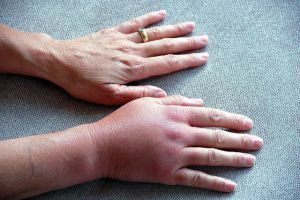
Thrombophlebitis is a dangerous disease that can be treated, but it should not be started. With timely treatment, the prognosis will only be positive.
Despite the simplicity of therapy at an early stage, the disease is easier to prevent than to treat it. First of all, it is worth moving as much as possible, sport should be a part of the way of life. Walking and gymnastics are recommended.
Also benefit from swimming, cycling and more. In addition, it is worth to give up shoes with high heels. You can also use folk methods of prevention, which involve taking tinctures of St. John's wort, dog rose or cranberry.
